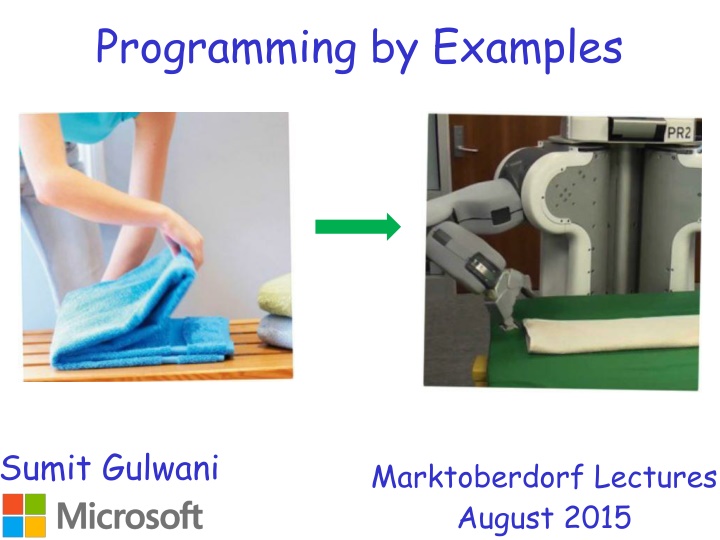
DSL and PBE Architecture Insights
Explore domain-specific languages (DSL) and programming by examples (PBE) architecture in this insightful content. Learn about the balanced expressiveness of DSLs and challenges faced in example-based specification. Dive deep into the evaluation of substring operators and the importance of efficient search strategies. Discover how programming paradigms enable efficient program ranking and function search algorithms.
Download Presentation

Please find below an Image/Link to download the presentation.
The content on the website is provided AS IS for your information and personal use only. It may not be sold, licensed, or shared on other websites without obtaining consent from the author. If you encounter any issues during the download, it is possible that the publisher has removed the file from their server.
You are allowed to download the files provided on this website for personal or commercial use, subject to the condition that they are used lawfully. All files are the property of their respective owners.
The content on the website is provided AS IS for your information and personal use only. It may not be sold, licensed, or shared on other websites without obtaining consent from the author.
E N D
Presentation Transcript
Programming by Examples Sumit Gulwani Marktoberdorf Lectures August 2015
Lecture 2 Domain-specific Languages 1
PBE Architecture Example-based specification Ordered set of Program Programs Ranking Function Search Algorithm DSL Challenge 1: Ambiguous/under-specified intent may result in unintended programs. Challenge 2: Designing efficient search strategy. 2
Domain-specific Language (DSL) Balanced Expressiveness Expressive enough to cover wide range of tasks Restricted enough to enable efficient search Restricted set of operators those with small inverse sets Restricted syntactic composition of those operators Natural computation patterns Increased user understanding/confidence Enables selection between programs, editing 3
FlashFill DSL ????? ?????? ?1, ,?????? ?? ?????? top-level expr T := if-then-else(B,C,T) | C condition-free expr C := Concatenate(A, C) | A SubStr(X, ) atomic expression A := | ConstantString input string X := x1 | x2| boolean expression B := 4
Substring Operator What is a good choice for in SubStr(X, ) ? Regular expression Not very expressive. Does not take context into account. For instance: content within parenthesis, second word Extended regular expression Too sophisticated for learning and readability. Desired computational pattern: Should involve simple regexes. Take context into account. 5
Substring Operator SubStr(X, P, P ) position expr P := Pos(X, R1, R2, K) Kth position in X whose left/right side matches with R1/R2. 6
Substring Operator Evaluation of Expr SubStr(x,p,p ) , where p=Pos(x,r1,r2,k) & p =Pos(x,r1 ,r2 ,k ) matches r1matches r2 matches r1 matches r2 p p w x Two special cases: r1 = r2 = ? : This describes the substring r2 = r1 = ? : This describes the context around the substring General case is very expressive (describes substring & context) Regular exprs are simple (they describe local properties). 7
Substring Operator SubStr(X, P, P ) position expr P := Pos(X, R, R, K) regular expr R := Seq(Token1, , Tokenn), where n 3. Token := Word | Number | Alphanumeric | [ | | K 2nd Word: SubStr(x, Pos(x,?,Word,2), Pos(x,Word,?,2)) Content within brackets: SubStr(x, Pos(s, [ ,?,1), Pos(x,?, ] ,1)) First 7 characters: Last 7 characters: SubStr(x, -8, -1) SubStr(x, 0, 7) 8
Substring Operator SubStr(X, P, P) position expr P := Pos(X, R, R, K) | K Restriction let x = X in SubStr(x, P, P) position expr P := Pos(x, R, R, K) | K Elegance let x = X in let p1 = P[x] in let p2 = P[x] in SubStr(x, p1, p2) position expr P[y] := Pos(y, R, R, K) | K 9
Substring Operator let x = X in let p1 = P[x] in let p2 = P[x] in SubStr(x, p1, p2) position expr P[y] := Pos(y, R, R, K) | K Increased Expressiveness let x = X in let p1 = P[x] in let p2 = P[x] | p1 + P[Suffix(x,p1)] in SubStr(x, p1, p2) position expr P[y] := Pos(y, R, R, K) | K First 7 chars in 2nd Word: SubStr(x, p1=Pos(x,?,Word,2), p1+7) Suffix(x,p) SubStr(x,p,-1) 10
Substring Operator let x = X in let p1 = P[x] in let p2 = P[x] | p1 + P[Suffix(x,p1)] in SubStr(x, p1, p2) position expr P[y] := Pos(y, R, R, K) | K Increased Expressiveness let x = X in let p1 = P[x] | let p0 = P[x] in (p0 + P[Suffix(s, p0)]) in let p2 = P[x] | p1 + P[Suffix(x,p1)] in SubStr(x, p1, p2) position expr P[y] := Pos(y, R, R, K) | K let p0 = Pos(x, [ ,?,1) in 2nd word within brackets: SubStr(x, p1 = p0+Pos(Suffix(x,p0), ?, Word, 2), p1+Pos(Suffix(x,p1), Word, ?, 2)) 11
FlashExtract DSL ?????? ? ????(???????) all lines L := Split(d, \n ) some lines N := Filter(L, ?z: F[z]) | FilterByPosition(L, init, iter) line filter function F[y] := Contains(y,r,K) | startsWith(y,r) [X] | Filter(L, ?z: F[prevLine(z)]) substr expr S := let x = X in let p1=P[x] | let p0=P[x] in (p0+P[Suffix(s,p0)]) in let p2 = P[x] | p1 + P[Suffix(x,p1)] in SubStr(x, p1, p2) position expr P[y] := Pos(y, R, R, K) | K 12
FlashExtract DSL ?????? ? ????(???????) Seq expr E := Map(N, ?z: PP[z]) | Map(Pos(d,R,R), ?z: PP[Suffix(d,z)]) | Merge(T1, T2) all lines L := Split(d, \n ) some lines N := Filter(L, ?z: F[z]) | FilterByPosition(L, init, iter) line filter function F[y] := Contains(y,r,K) | startsWith(y,r) [X] | Filter(L, ?z: F[prevLine(z)]) substr expr S := let x = X in SubStr(x, PP[x]) position pair PP[x] := let p1=P[x] | let p0=P[x] in (p0+P[Suffix(s,p0)]) in let p2 = P[x] | p1 + P[Suffix(x,p1)] in (p1,p2) position expr P[y] := Pos(y, R, R, K) | K 13
FlashExtract DSL ?????? ? ????(???????1, .,????????) top-level expr T := Plan(?, P, (k1,D1), ,(kn-1,Dn-1)), where 0 ki < i. Plan(?, P, (k1,D1), ,(kn-1,Dn-1)) Map(P, ?z: R), where R[?(0)] = z, R[?(i)] -> Di(R[ki]) primary keys P := E derived value D := ?z: PP[Suffix(d,Snd(z))] 14
Table Re-formatting Input: Semi-structured spreadsheet Output: Relational table
Table Re-formatting Input: Semi-structured spreadsheet Output: Relational table
FlashRelate DSL ??????? ??? ? ???? ????1, ,????? top-level expr T := Plan(?, P, (k1,D1), ,(kn-1,Dn-1)), where 0 ki < i. primary keys P := cell filter fn F[y] := Boolean constraint over Filter(d.Cells, ?z: F[z]) y.Coordinates, y.Content, y.Neighbors ?z: Neighbor(z,K,K) derived value D := | ?z: MoveUntil(z, Direction, ?y: F[y]) 18
Summary: Design of DSLs for Synthesis Balanced Expressiveness Expressive enough to cover wide range of tasks Build out iteratively from a simple core. Restricted enough to enable efficient search Use let construct for syntactic restrictions. Natural computation patterns Use function definitions for reusability. 19

